Whether due to a dairy intolerance, cows milk allergy or personal choice to follow a vegetarian or vegan lifestyle, getting enough calcium from plant based sources alone can be difficult to achieve. Difficult, but not impossible. With some careful planning it is possible for vegetarians to use plant based sources of calcium to achieve their calcium needs.
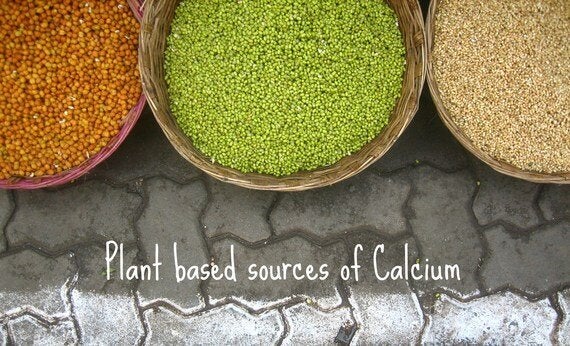
A number of plants, fruits and vegetables contain calcium but can be limited because of low bioavailability or huge quantities required. I've heard about oranges and broccoli containing calcium, but will I need to eat bucketloads to equal a glass of milk? Off I go to investigate!
HOW MUCH CALCIUM DO WE NEED?
Calcium requirements and recommendations vary from country to country. These also vary according to gender and age with values typically increasing as we get older to account for reduced absorption. In the UK, the general adult population is recommended to consume 800mg of calcium a day unless they have coeliac disease which increases it to 1000-1500mg per day. Australian calcium recommendations are set higher at 1000mg daily for adults.
BIOAVAILABILITY
Bioavailability is a measure of how much calcium is absorbed and available for the body to utilise. I doubt that any nutrient is 100% bioavailable as many factors can influence this. Oxalates and phytates are compounds naturally present in plants that can negatively impact how available calcium sourced from plants is.
Cow's milk is usually used as a reference point with 1 cup (240ml) of milk set as a standard 'serve'. A study in 1999 looked at the bioavailability of various sources of calcium comparing how well they were absorbed compared to 1 cup of cows milk, which has approximately 32% of the calcium absorbed. To absorb the same amount of calcium from broccoli from that cup of milk, you would need to eat 2 1/2 cups of broccoli, 5 cups of red beans, 1 1/2 cups of kale or a massive 8 cups of spinach!
It's worth keeping that in mind for any food containing calcium, just because 1 cup of kale may contain 87mg of calcium doesn't meant that the entire amount is available and absorbed by the body. I've tried to use realistic portion sizes and was fascinated to see how rich in calcium herbs are. While it would be a fantastic way to bump up your calcium intake at 2110mg per 100g of dried basil, I can't really see anyone eating more than a tablespoon at a time!
VEGETABLES
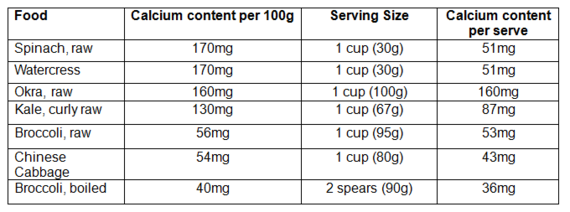
FRESH & DRIED FRUIT
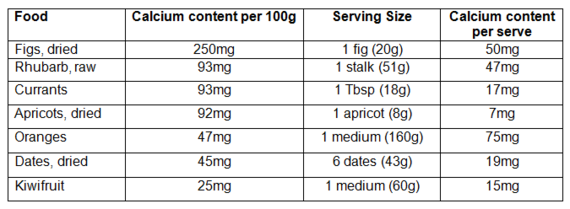
NUTS & SEEDS
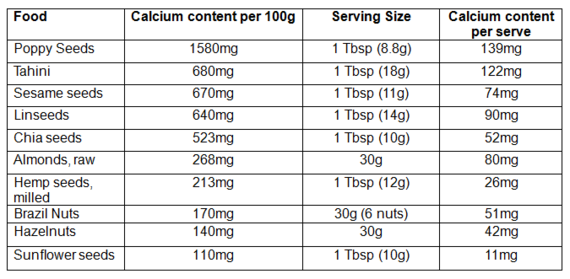
BEANS & LEGUMES

HERBS
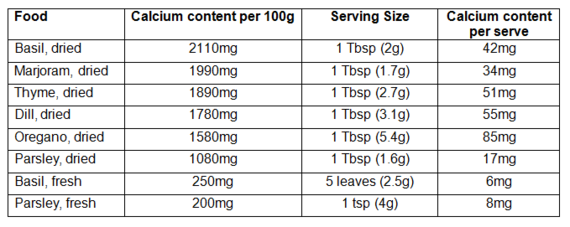
GRAINS & CEREALS

MISCELLANEOUS

Nutrition values can vary from country to country depending on soil, agriculture techniques etc. The values I've listed are UK specific so may differ slightly to values obtained elsewhere.
Gemma
This post first appeared on Dietitian without Borders
Image adapted from 'Road-side pulse' by Meena Kadri Licensed under a Creative Commons Attribution-Share-Alike 2.0 Generic (CC BY-SA 2.0). Accessed 22nd October 2014